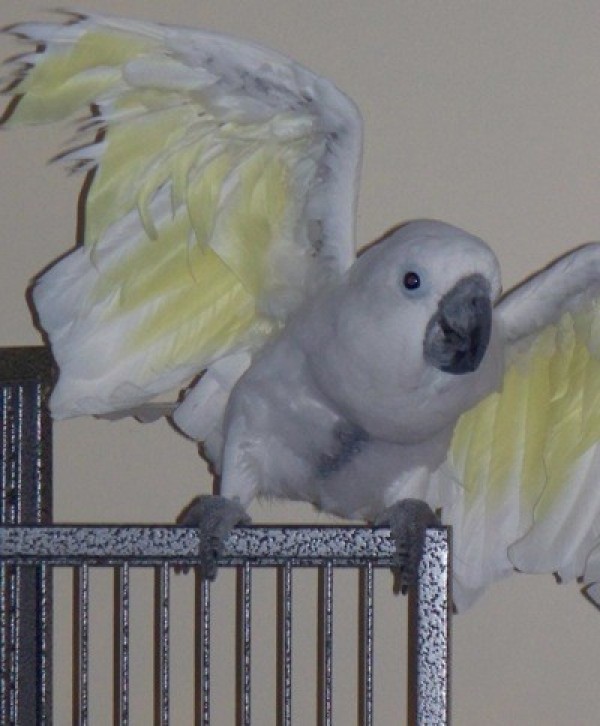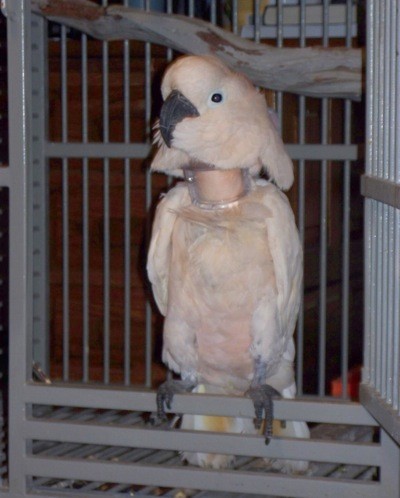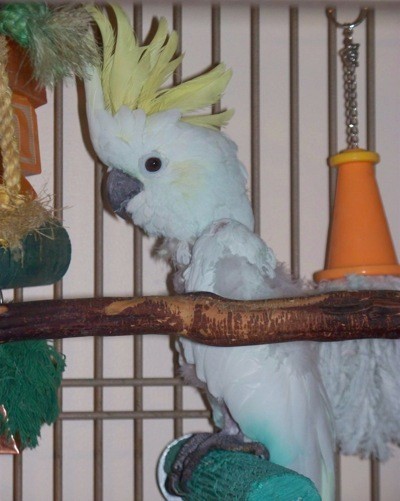
Crest Position: When the crest is mostly back, the bird is generally relaxed and content. When the crest is lifted, the bird may be excited by playtime, or something new and interesting. If the crest is standing high and at attention, it is an indication of excitement or fear. An absolutely terrified cockatoo will slick her crest down flat and may also crouch and hiss.

Head Shaking: Some parrots, particularly African Greys, shake their heads as if there is water in the ears. No one really knows why they do this and it seems to be normal. If your bird is doing this a bit, it may be a sign of an ear or nasal infection.
Quivering Wings: A parrot that's shivering or has quivering wings, may be frightened, overly excited, or in breeding mode.
Beak And Body Language: An open beak, crouched posture, hissing yelling, and lunging is prime biting posture. This is a frightened or displaying parrot.
Potty Language: Backing up a step or two or crouching on the perch, lifting tail, and even making a little noise. You can catch "poop posture" before the poop happens and move the parrot to another place if you want him to poop elsewhere.
Chicken Scratching: African Greys and sometimes other parrots will "chicken scratch" at the bottom of their cage or on the carpet. Greys in particular do this because digging is part of their natural wild behavior. If you don't mind the mess, you can give your Grey a sandbox (or litter box to play in, using clean sand from the toy store).
Eye Pinning (dilate/contract pupils): A parrot whose pupils are pinning in and out is excited and may be in bite mode. Some parrots do this when they are excited about something that they like, such as new toys or good food.
Wing Drooping: Wing drooping can be part of a mating dance, but in a listless bird it can indicate illness.
Blushing: Some parrots blush, the blue and gold and the Buffon's macaws, for example. It's not for the same reason that humans blush, however. It's more about excitement and mating ritual.
Back down, feet up: Some parrots play on their backs. Just make sure the bird is moving and breathing; many a "parront" has found their feathered friend expired in the bottom of the cage when they uncovered the cage in the morning. That's one of the reasons to pay particular attention to your bird's body language.
When the feathers are pulled up close to the beak; covering the bottom part of the beak you have a happy and contented bird.

Source: Parrots For Dummies, as well as observations that I have made from volunteering at Avian Rescue and having 7 parrots in my house.
The Umbrella Cockatoo (U2) in the first picture is an example of "displaying". The second picture of the Moluccan Cockatoo (M2), is a picture of a contented bird. The third picture of the Lessor Sulphur Crested Cockatoo, (LSC2) is a picture of a nervous bird; note the raised crest.
By one.of.a.kind from AL
Add your voice! Click below to comment. ThriftyFun is powered by your wisdom!
This is wonderful! I was wondering what that expression Perry keeps getting on his face was! He is happy!
I am so glad you shared this and I am voting for it!
Robyn
Add your voice! Click below to comment. ThriftyFun is powered by your wisdom!